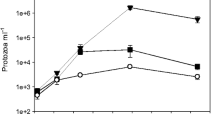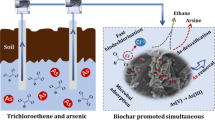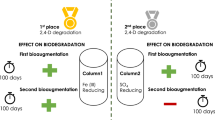Abstract
The pesticide metabolite 2,6-dichlorobenzamide (BAM) is very persistent in both soil and groundwater and has become one of the most frequently detected groundwater micropollutants. BAM is not removed by the physico-chemical treatment techniques currently used in drinking water treatment plants (DWTP); therefore, if concentrations exceed the legal threshold limit, it represents a sizeable problem for the stability and quality of drinking water production, especially in places that depend on groundwater for drinking water. Bioremediation is suggested as a valuable strategy for removing BAM from groundwater by deploying dedicated BAM-degrading bacteria in DWTP sand filters. Only a few bacterial strains with the capability to degrade BAM have been isolated, and of these, only three isolates belonging to the Aminobacter genus are able to mineralise BAM. Considerable effort has been made to elucidate degradation pathways, kinetics and degrader genes, and research has recently been presented on the application of strain Aminobacter sp. MSH1 for the purification of BAM-contaminated water. The aim of the present review was to provide insight into the issue of BAM contamination and to report on the current status and knowledge with regard to the application of microorganisms for purification of BAM-contaminated water resources. This paper discusses the prospects and challenges for bioaugmentation of DWTP sand filters with specific BAM-degrading bacteria and identifies relevant perspectives for future research.


Similar content being viewed by others
References
Agriculture & Environment Research Unit (2016) PPDB: Pesticide Properties DataBase. University of Hertfordshire, http://sitem.herts.ac.uk/aeru/footprint/index2.htm.
Albers CN, Jacobsen OS, Aamand J (2014) Using 2,6-dichlorobenzamide (BAM) degrading Aminobacter sp. MSH1 in flow through biofilters—initial adhesion and BAM degradation potentials. Appl Microbiol Biotechnol 98:957–967. doi:10.1007/s00253-013-4942-6
Albers CN, Ellegaard-Jensen L, Harder CB, Rosendahl S, Knudsen BE, Ekelund F, Aamand J (2015a) Groundwater chemistry determines the prokaryotic community structure of waterworks sand filters. Environ Sci Technol 49:839–846. doi:10.1021/es5046452
Albers CN, Feld L, Ellegaard-Jensen L, Aamand J (2015b) Degradation of trace concentrations of the persistent groundwater pollutant 2,6-dichlorobenzamide (BAM) in bioaugmented rapid sand filters. Water Res 83:61–70. doi:10.1016/j.watres.2015.06.023
Benner J, Helbling DE, Kohler HPE, Wittebol J, Kaiser E, Prasse C, Ternes TA, Albers CN, Aamand J, Horemans B, Springael D, Walravens E, Boon N (2013) Is biological treatment a viable alternative for micropollutant removal in drinking water treatment processes? Water Res 47:5955–5976. doi:10.1016/j.watres.2013.07.015
Beynon KI, Wright AN (1968) Persistence, penetration, and breakdown of chlorthiamid and dichlobenil herbicides in field soils of different types. J Sci Food Agric 19:718–722. doi:10.1002/jsfa.2740191208
Beynon KI, Wright AN (1972) The fates of the herbicides chlorthiamid and dichlobenil in relation to residues in crops, soils, and animals. In: Gunther FA, Gunther JD (eds) Residue reviews: residues of pesticides and other contaminants in the Total environment. Springer New York, New York, pp 23–53. doi:10.1007/978-1-4615-8485-8_2
Björklund E, Anskjær GG, Hansen M, Styrishave B, Halling-Sørensen B (2011) Analysis and environmental concentrations of the herbicide dichlobenil and its main metabolite 2,6-dichlorobenzamide (BAM): a review. Sci Total Environ 409:2343–2356. doi:10.1016/j.scitotenv.2011.02.008
Clausen L, Larsen F, Albrechtsen HJ (2004) Sorption of the herbicide dichlobenil and the metabolite 2,6-dichlorobenzamide on soils and aquifer sediments. Environ Sci Technol 38:4510–4518. doi:10.1021/es035263i
Clausen L, Arildskov NP, Larsen F, Aamand J, Albrechtsen H-J (2007) Degradation of the herbicide dichlobenil and its metabolite BAM in soils and subsurface sediments. J Contam Hydrol 89:157–173. doi:10.1016/j.jconhyd.2006.04.004
Dealtry S, Ding G-C, Weichelt V, Dunon V, Schlüter A, Martini MC, Papa MFD, Lagares A, Amos GCA, Wellington EMH, Gaze WH, Sipkema D, Sjöling S, Springael D, Heuer H, van Elsas JD, Thomas C, Smalla K (2014) Cultivation-independent screening revealed hot spots of IncP-1, IncP-7 and IncP-9 plasmid occurrence in different environmental habitats. PLoS One 9:e89922. doi:10.1371/journal.pone.0089922
Desaint S, Hartmann A, Parekh NR, Fournier JC (2000) Genetic diversity of carbofuran-degrading soil bacteria. FEMS Microbiol Ecol 34:173–180. doi:10.1016/S0168-6496(00)00092-1
Dunon V, Sniegowski K, Bers K, Lavigne R, Smalla K, Springael D (2013) High prevalence of IncP-1 plasmids and IS1071 insertion sequences in on-farm biopurification systems and other pesticide-polluted environments. FEMS Microbiol Ecol 86:415–431. doi:10.1111/1574-6941.12173
Ekelund F, Harder CB, Knudsen BE, Aamand J (2015) Aminobacter MSH1-mineralisation of BAM in sand-filters depends on biological diversity. PLoS One 10:e0128838. doi:10.1371/journal.pone.0128838
Ellegaard-Jensen L, Albers CN, Aamand J (2016) Protozoa graze on the 2,6-dichlorobenzamide (BAM)-degrading bacterium Aminobacter sp. MSH1 introduced into waterworks sand filters. Appl Microbiol Biotechnol 100:8965–8973. doi:10.1007/s00253-016-7710-6
European Commission EU (2011) COMMISSION IMPLEMENTING DECISION of 11 April 2011 concerning the non-inclusion of dichlobenil in Annex I to Council Directive 91/414/EEC. Official Journal of the European Union, Brussels, 11 April 2011.
European Council EU (1998) Drinking Water Directive (COUNCIL DIRECTIVE 98/83/EC). Official Journal of the European Communities, Brussels, 3 November 1998.
Harwood CS, Parales RE (1996) The beta-ketoadipate pathway and the biology of self-identity. Annu Rev Microbiol 50:553–590. doi:10.1146/annurev.micro.50.1.553
Hernández-Leal L, Temmink H, Zeeman G, Buisman CJ (2011) Removal of micropollutants from aerobically treated grey water via ozone and activated carbon. Water Res 45:2887–2896
Holtze MS, Sørensen J, Hansen HCB, Aamand J (2006) Transformation of the herbicide 2,6-dichlorobenzonitrile to the persistent metabolite 2,6-dichlorobenzamide (BAM) by soil bacteria known to harbour nitrile hydratase or nitrilase. Biodegradation 17:503–510. doi:10.1007/s10532-005-9021-y
Holtze MS, Hansen HCB, Juhler RK, Sørensen J, Aamand J (2007) Microbial degradation pathways of the herbicide dichlobenil in soils with different history of dichlobenil-exposure. Environ Pollut 148:343–351
Holtze MS, Sørensen SR, Sørensen J, Aamand J (2008) Microbial degradation of the benzonitrile herbicides dichlobenil, bromoxynil and ioxynil in soil and subsurface environments—insights into degradation pathways, persistent metabolites and involved degrader organisms. Environ Pollut 154:155–168. doi:10.1016/j.envpol.2007.09.020
Horemans B, Raes B, Vandermaesen J, Simanjuntak Y, Brocatus H, T’Syen J, Degryse J, Boonen J, Wittebol J, Lapanje A, Sørensen SR, Springael D (2016) Biocarriers improve bioaugmentation efficiency of a rapid sand filter for the treatment of 2,6-dichlorobenzamide (BAM)-contaminated drinking water. Environ Sci Technol. doi:10.1021/acs.est.6b05027
Janniche GS, Clausen L, Albrechtsen H-J (2011) Inherent mineralization of 2,6-dichlorobenzamide (BAM) in unsaturated zone and aquifers—effect of initial concentrations and adaptation. Environ Pollut 159:2801–2807. doi:10.1016/j.envpol.2011.05.010
Johnsen AR (2015) Pesticider. In: Thorling L (ed) Grundvand. Status og udvikling 1989–2014. GEUS, Denmark, pp 105–129 (in Danish)
Kämpfer P, Neef A, Salkinoja-Salonen MS, Busse HJ (2002) Chelatobacter heintzii (Auling et al. 1993) is a later subjective synonym of Aminobacter aminovorans (Urakami et al. 1992). Int J Syst Evol Microbiol 52:835–839. doi:10.1099/ijs.0.01897-0
Kimura K, Amy G, Drewes JE, Heberer T, Kim T-U, Watanabe Y (2003) Rejection of organic micropollutants (disinfection by-products, endocrine disrupting compounds, and pharmaceutically active compounds) by NF/RO membranes. J Membr Sci 227:113–121
Knudsen BE, Ellegaard-Jensen L, Albers CN, Rosendahl S, Aamand J (2013) Fungal hyphae stimulate bacterial degradation of 2,6-dichlorobenzamide (BAM). Environ Pollut 181:122–127. doi:10.1016/j.envpol.2013.06.013
van der Kooij D (1992) Assimilable organic carbon as an indicator of bacterial regrowth. J Am Water Works Assoc 84:57–65
Król JE, Penrod JT, McCaslin H, Rogers LM, Yano H, Stancik AD, Dejonghe W, Brown CJ, Parales RE, Wuertz S, Top EM (2012) Role of IncP-1β plasmids pWDL7::rfp and pNB8c in chloroaniline catabolism as determined by genomic and functional analyses. Appl Environ Microbiol 78:828–838. doi:10.1128/aem.07480-11
Layh N, Hirrlinger B, Stolz A, Knackmuss H-J (1997) Enrichment strategies for nitrile-hydrolysing bacteria. Appl Microbiol Biotechnol 47:668–674. doi:10.1007/s002530050993
Madsen HT, Ammi-said A, Van der Bruggen B, Søgaard EG (2015) Addition of adsorbents to nanofiltration membrane to obtain complete pesticide removal. Water Air Soil Pollut 226:160. doi:10.1007/s11270-015-2419-1
Martini MC, Albicoro FJ, Nour E, Schlüter A, van Elsas JD, Springael D, Smalla K, Pistorio M, Lagares A, Del Papa MF (2015) Characterization of a collection of plasmid-containing bacteria isolated from an on-farm biopurification system used for pesticide removal. Plasmid 80:16–23. doi:10.1016/j.plasmid.2015.05.001
McDonald IR, Kämpfer P, Topp E, Warner KL, Cox MJ, Connell Hancock TL, Miller LG, Larkin MJ, Ducrocq V, Coulter C, Harper DB, Murrell JC, Oremland RS (2005) Aminobacter ciceronei sp. nov. and Aminobacter lissarensis sp. nov., isolated from various terrestrial environments. Int J Syst Evol Microbiol 55:1827–1832. doi:10.1099/ijs.0.63716-0
Meth-Cohn O, Wang M-X (1997) An in-depth study of the biotransformation of nitriles into amides and/or acids using Rhodococcus rhodochrous AJ2701. J Chem Soc Perkin 1:1099–1104. doi:10.1039/a607977f
Ministry of Agricultural Food and Rural affairs (2015) Guide to weed control 2016–2017. Ministry of Agriculture, Food and Rural Affairs, Ontario, Canada http://www.omafra.gov.on.ca/english/crops/pub75/pub75.pdf.
Miyazaki S, Sikka HC, Lynch RS (1975) Metabolism of dichlobenil by microorganisms in the aquatic environment. J Agric Food Chem 23:365–368. doi:10.1021/jf60199a026
Montgomery M, Yu TC, Freed VH (1972) Kinetics of dichlobenil degradation in soil. Weed Res 12:31–36. doi:10.1111/j.1365-3180.1972.tb01184.x
Porazzi E, Pardo Martinez M, Fanelli R, Benfenati E (2005) GC–MS analysis of dichlobenil and its metabolites in groundwater. Talanta 68:146–154. doi:10.1016/j.talanta.2005.04.044
Pukkila V, Kontro MH (2014) Dichlobenil and 2,6-dichlorobenzamide (BAM) dissipation in topsoil and deposits from groundwater environment within the boreal region in southern Finland. Environ Sci Pollut Res Int 21:2289–2297. doi:10.1007/s11356-013-2164-1
Pukkila V, Gustafsson J, Tuominen J, Aallonen A, Kontro MH (2009) The most-probable-number enumeration of dichlobenil and 2,6-dichlorobenzamide (BAM) degrading microbes in Finnish aquifers. Biodegradation 20:679–686. doi:10.1007/s10532-009-9255-1
Reemtsma T, Alder L, Banasiak U (2013) Emerging pesticide metabolites in groundwater and surface water as determined by the application of a multimethod for 150 pesticide metabolites. Water Res 47:5535–5545. doi:10.1016/j.watres.2013.06.031
Ren D, Madsen JS, Sorensen SJ, Burmolle M (2015) High prevalence of biofilm synergy among bacterial soil isolates in cocultures indicates bacterial interspecific cooperation. ISME J 9:81–89. doi:10.1038/ismej.2014.96
Reungoat J, Macova M, Escher BI, Carswell S, Mueller JF, Keller J (2009) Removal of micropollutants and reduction of biological activity in a full scale reclamation plant using ozonation and activated carbon filtration. Water Res 44:625–637
Sahar E, David I, Gelman Y, Chikurel H, Aharoni A, Messalem R, Brenner A (2011) The use of RO to remove emerging micropollutants following CAS/UF or MBR treatment of municipal wastewater. Desalination 273:142–147
Schipper PNM, Vissers MJM, van der Linden AMA (2008) Pesticides in groundwater and drinking water wells: overview of the situation in the Netherlands. Water Sci Technol 57:1277–1286. doi:10.2166/wst.2008.255
Schlömann M (1994) Evolution of chlorocatechol catabolic pathways—conclusions to be drawn from comparisons of lactone hydrolases. Biodegradation 5:301–321. doi:10.1007/BF00696467
Schultz-Jensen N, Knudsen B, Frkova Z, Aamand J, Johansen T, Thykaer J, Sørensen S (2014) Large-scale bioreactor production of the herbicide-degrading Aminobacter sp. strain MSH1. Appl Microbiol Biotechnol 98:2335–2344. doi:10.1007/s00253-013-5202-5
Schultz-Jensen N, Aamand J, Sørensen SR (2016) Bioaugmentation potential of free and formulated 2,6-dichlorobenzamide (BAM) degrading Aminobacter sp. MSH1 in soil, sand and water. AMB Express 6:33. doi:10.1186/s13568-016-0204-1
Sekhar A, Horemans B, Aamand J, Sørensen SR, Vanhaecke L, Vanden Bussche J, Hofkens J, Springael D (2016) Surface colonization and activity of the 2,6-dichlorobenzamide (BAM) degrading Aminobacter sp. strain MSH1 at macro- and micropollutant BAM concentrations. Environ Sci Technol 50:10123–10133. doi:10.1021/acs.est.6b01978
Simonsen A, Holtze MS, Sørensen SR, Sørensen SJ, Aamand J (2006) Mineralisation of 2,6-dichlorobenzamide (BAM) in dichlobenil-exposed soils and isolation of a BAM-mineralising Aminobacter sp. Environ Pollut 144:289–295
Simonsen A, Badawi N, Anskjaer GG, Albers CN, Sorensen SR, Sorensen J, Aamand J (2012) Intermediate accumulation of metabolites results in a bottleneck for mineralisation of the herbicide metabolite 2,6-dichlorobenzamide (BAM) by Aminobacter spp. Appl Microbiol Biotechnol 94:237–245. doi:10.1007/s00253-011-3591-x
Sjøholm OR, Aamand J, Sørensen J, Nybroe O (2010a) Degrader density determines spatial variability of 2,6-dichlorobenzamide mineralisation in soil. Environ Pollut 158:292–298
Sjøholm OR, Nybroe O, Aamand J, Sørensen J (2010b) 2,6-Dichlorobenzamide (BAM) herbicide mineralisation by Aminobacter sp. MSH1 during starvation depends on a subpopulation of intact cells maintaining vital membrane functions. Environ Pollut 158:3618–3625. doi:10.1016/j.envpol.2010.08.006
Sørensen SR, Holtze MS, Simonsen A, Aamand J (2007) Degradation and mineralization of nanomolar concentrations of the herbicide dichlobenil and its persistent metabolite 2,6-dichlorobenzamide by Aminobacter spp. isolated from dichlobenil-treated soils. Appl Environ Microbiol 73:399–406. doi:10.1128/aem.01498-06
Springael D, Ryngaert A, Merlin C, Toussaint A, Mergeay M (2001) Occurrence of Tn4371-related mobile elements and sequences in (chloro)biphenyl-degrading bacteria. Appl Environ Microbiol 67:42–50. doi:10.1128/AEM.67.1.42-50.2001
Top EM, Springael D (2003) The role of mobile genetic elements in bacterial adaptation to xenobiotic organic compounds. Curr Opin Biotechnol 14:262–269. doi:10.1016/S0958-1669(03)00066-1
Törnquist M, Kreuger J, Adielsson S (2007) Occuring of pesticides in Swedish water resources against a background of national risk-reduction programms - results from 20 years of monitoring. In: XIII Symposium Pesticide Chemistry - Environmental Fate and Human Health, Piacenza, Italy, 2007.
T’Syen J, Tassoni R, Hansen L, Sørensen SJ, Leroy B, Sekhar A, Wattiez R, De Mot R, Springael D (2015) Identification of the amidase BbdA that initiates biodegradation of the groundwater micropollutant 2,6-dichlorobenzamide (BAM) in Aminobacter sp MSH1. Environ Sci Technol 49:11703–11713. doi:10.1021/acs.est.5b02309
Urakami T, Araki H, Oyanagi H, Suzuki KI, Komagata K (1992) Transfer of Pseudomonas aminovorans (den Dooren de Jong 1926) to Aminobacter gen. nov. as Aminobacter aminovorans comb. nov. and description of Aminobacter aganoensis sp. nov. and Aminobacter niigataensis sp. Nov. Int J Syst Bacteriol 42:84–92
Vandermaesen J, Horemans B, Degryse J, Boonen J, Walravens E, Springael D (2016) Mineralization of the common groundwater pollutant 2,6-dichlorobenzamide (BAM) and its metabolite 2,6-dichlorobenzoic acid (2,6-DCBA) in sand filter units of drinking water treatment plants. Environ Sci Technol 50:10114–10122. doi:10.1021/acs.est.6b01352
Verloop A, Nimmo WB (1970) Metabolism of dichlobenil in sandy soil. Weed Res 10:65–70. doi:10.1111/j.1365-3180.1970.tb00924.x
Veselá AB, Pelantová H, Šulc M, Macková M, Lovecká P, Thimová M, Pasquarelli F, Pičmanová M, Pátek M, Bhalla TC, Martínková L (2012) Biotransformation of benzonitrile herbicides via the nitrile hydratase–amidase pathway in rhodococci. J Ind Microbiol Biot 39:1811–1819. doi:10.1007/s10295-012-1184-z
Vlaamse Milieumaatschappij (VMM) (2012) Pesticiden in het grondwater in Vlaanderen 64 (in Dutch)
Vosáhlová J, Pavlů L, Vosáhlo J, Brenner V (1997) Communication to the editor degradation of Bromoxynil, Ioxynil, Dichlobenil and their mixtures by Agrobacterium radiobacter 8/4. Pestic Sci 49:303–306. doi:10.1002/(sici)1096-9063(199703)49:3<303::aid-ps519>3.0.co;2-t
Werlen C, Kahler HPE, Van Der Meer JR (1996) The broad substrate chlorobenzene dioxygenase and cis-chlorobenzene dihydrodiol dehydrogenase of Pseudomonas sp. strain P51 are linked evolutionarily to the enzymes for benzene and toluene degradation. J Biol Chem 271:4009–4016. doi:10.1074/jbc.271.8.4009
Yuan Z, VanBriesen JM (2008) Bacterial growth yields on EDTA, NTA, and their biodegradation intermediates. Biodegradation 19:41–52. doi:10.1007/s10532-007-9113-y
Acknowledgements
Lea Ellegaard-Jensen, Jens Aamand and Lars Hestbjerg Hansen were supported by the research project MEM2BIO (Innovation Fund Denmark, contract number 5157-00004B).
Benjamin Horemans was supported by the FWO postdoctoral fellowship grant (12Q0215N) and the BELSPO IAP-project μ-manager no. P7/25. Bart Raes was supported by the C1 project no. C14/15/043 of KU Leuven.
Author information
Authors and Affiliations
Corresponding author
Ethics declarations
Conflict of interest
The authors declare that they have no conflict of interest.
Ethical approval
This article does not contain any studies with human participants or animals performed by any of the authors.
Rights and permissions
About this article
Cite this article
Ellegaard-Jensen, L., Horemans, B., Raes, B. et al. Groundwater contamination with 2,6-dichlorobenzamide (BAM) and perspectives for its microbial removal. Appl Microbiol Biotechnol 101, 5235–5245 (2017). https://doi.org/10.1007/s00253-017-8362-x
Received:
Revised:
Accepted:
Published:
Issue Date:
DOI: https://doi.org/10.1007/s00253-017-8362-x




